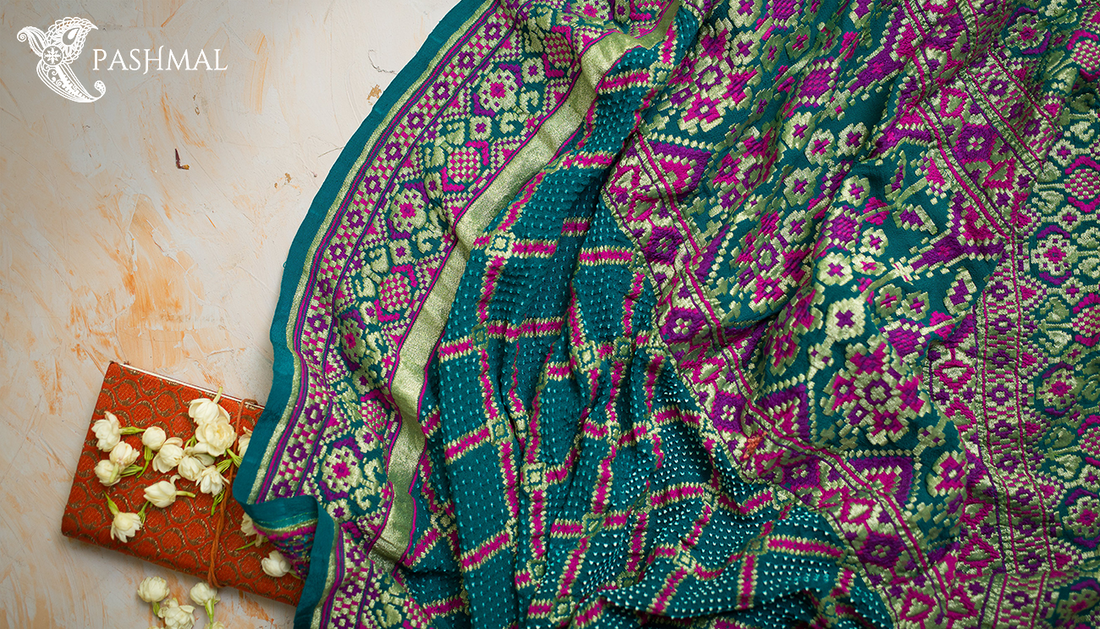In the history of heritage textile craftsmanship, Kani weaving is a testament to the age-old tradition and unparalleled skill preserved in the valleys of Kashmir. Originating in the 15th century, this intricate art form has withstood the test of time and flourished into a symbol of elegance and cultural richness.
In this blog post, we will share five fascinating facts about the timeless Kani weaving. including the history, the process, different Kani shawl designs, and the cultural significance that makes Kani weave a treasure trove of artistic wonder. Let’s get started!
5 Things You Must Know About Kani Shawls
1. Origin of Kani Shawl Trace Back to Kashmir

Legend has it that the heritage Kani shawl designs found their way to the picturesque region of Kashmir in the 15th century. Persian and Turkish weavers brought this mysterious craft to the attention of Ghiyas-ud-Din Zain-ul-Abidin, the eighth Sultan of Kashmir. Since that historical moment, the art of Kani weaving has not only survived but has flourished, capturing worldwide admiration.
- Origin of the Name Kani
The word Kani carries a dual meaning, reflecting its origin and the process. Firstly, it refers to the small wooden oblong spool or Kanis in Kashmiri. This wooden bobbin plays a crucial role in weaving, especially for winding the weft threads. Secondly, Kani also represents the village of Kanihama, believed to be the birthplace and origin of this intricate craft.
- The Evolution of Kani Shawls from Monopoly
Kanihama, the village associated with the genesis of Kani shawls, once held a monopoly over this exquisite craft. Over time, however, artisans from other villages learned and mastered the art, spreading its influence across the region. The name Kanihama reflects the craft's essence, combining Kani, meaning wooden sticks, with Hama, signifying village.
Discover More: The Art of Kani Weaving: Kashmir's Gift to the World of Textiles
2. Kani Weaving is Labor-Intensive & Time-Consuming

Like other Kashmiri shawls, weaving a Kani shawl design is a labour-intensive process that unfolds through various stages, each handled by specialized artisans. The process includes the following steps:
- Design Preparation: A pattern drawer, known as Nakkash, creates the initial Kani shawl designs. Then, they pass the design to the Tarah-guru, who determines the colour combination and calculates the required yarns for each shade.
- Warp Preparation: The warp-maker (Nakatu) and warp dresser (Pennakamgur) collaborate to prepare the warp on a four-shaft treadle loom based on the details provided by the Tarah-guru.
- Talim Notation: The Talim-guru prepares a shorthand notation or Talim based on the specific Kani shawl design. This notation, created on graph paper, guides the master weaver to instruct the weavers.
- Handweaving with Kanis: Weavers use wooden or cane needles, also known as Kani, to hand-weave the weft threads. In intricate Kani shawl designs, artisans may use up to fifty Kanis with corresponding coloured yarn for a single design.
- Joining the Designs: In cases where multiple looms are employed, a skilled needleworker seamlessly joins separate designs into a single, cohesive shawl.
Weaving a Kani shawl demands extraordinary patience, as evidenced by the fact that a skilled weaver can produce a maximum of one inch per day, depending on the complexity of a design. Considering the size, detailing, and design intricacies, it can take 6 to 18 months to complete a single Kani shawl.
Discover More: From History to Trends: All You Need to Know About Shawls
3. Kani Shawls are Expensive
While Kani shawls are undeniably expensive, their price reflects the meticulous craftsmanship and time invested in each creation. These exceptionally lightweight and natural shawls, available online, can range up to 1 lakh. The investment secures a breathtaking piece of art and contributes to the livelihoods of dedicated weavers who pour their skill and effort into crafting these masterpieces.
4. Kani Shawls have Different Varieties
- Kani Jamawar Shawl: It usually takes up to two years to complete an authentic Jamawar Kani shawl. The entire base of the Jamawar shawl features Kani patterns and traditional Kashmiri embroidery motifs.
- Palladaar Kani Pashmina: This type of Kani shawl design is woven specifically at the borders or Pallas in the local language. As a result, unlike Jamawar Shawl, this variant takes less time to complete.
- Moon Shawl: It features a full medallion design at the centre and similar designs at all four corners.
The revival and sustainability of Kani weaving go beyond traditional shawls. Artisans have innovated to meet the demands of the 21st century, creating products such as Kani jackets, scarves, kurtas, dupattas, caps, mufflers, and other apparel. This diversification ensures the preservation and evolution of this ancient craft.
5. Kani Weaving has Acquired Global Acclamation

The magnificence of Kani weaving has transcended borders and earned its place in some of the world's most esteemed institutions. Some exquisite pieces of this heritage craft are displayed in London's Victoria and Albert Museum, the Department of Islamic Art at New York's Metropolitan Museum of Art, and Musée des Arts Décoratifs in Paris. This global recognition underscores the cultural and artistic significance of Kani shawls.
Where Can You Find the Best Kashmiri Kani Shawls & Apparel?
If you are looking for the best Kashmiri Kani shawls or other apparel, Pashmal can be your one-stop destination. Crafted by skilled artisans, every piece boasts intricate Kani shawl designs ranging from vibrant florals to classic motifs. Each piece is not merely an accessory but a wearable piece of art that imparts warmthPashma stands as a destination where craftsmanship and luxury unite in perfect harmony. Visit our website to shop for our exclusive Kani shawls, stoles, and suits collection.




